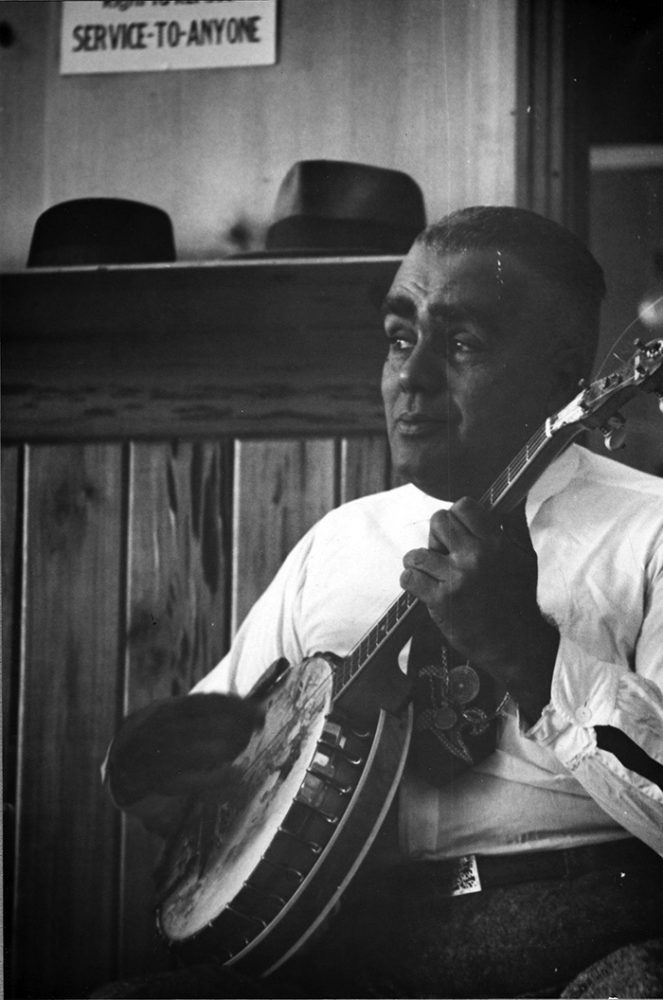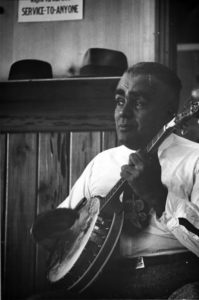Creole George Guesnon
“Creole” George Guesnon was a traditional jazz banjo player and vocalist from New Orleans, known as a stunningly innovative performer and composer who recorded nearly 100 of his own compositions for the Icon record label.

Courtesy of Tulane University, William Ransom Hogan Archive of New Orleans Jazz
George Guesnon. Hurley, Jack (Photographer)
“Creole” George Guesnon was a traditional jazz banjo player and vocalist from New Orleans. Known for performing with heavily blues-influenced inflection and aesthetics, Guesnon was a stunningly innovative performer and composer who recorded nearly 100 of his own compositions for the Icon record label. Although Guesnon traveled and performed in numerous locales during his lifetime, including Jackson, Mississippi, and New York City, where he lived and worked for a time with Jelly Roll Morton, the last decades of his life found him back in New Orleans, where he performed often at Preservation Hall until his retirement in 1965.
George Guesnon was born on May 25, 1907, in New Orleans. Guesnon’s extended Creole family (hence the nickname) was headed by his father, a plasterer, and his uncle, a musician, from whom George learned to play ukulele at age twelve. During his teenage years he also took up the banjo, and was playing that instrument with Kid Clayton’s Happy Pals at the Hummingbird Cabaret in New Orleans by age twenty. Because he was largely self-taught on this instrument, Guesnon played banjo with a ukulele tuning until he began studying formally with John Marrero, brother of famed banjoist Lawrence Marrero, who taught the young Guesnon to play banjo in the standard way. Guesnon is remembered best for his unique performance style on the banjo, but his distinctive vocal talents came to be in even more demand than his banjo playing.
In 1928 Guesnon replaced John Marrero in Celestin’s Original Tuxedo Jazz Orchestra. The following year he replaced New Orleans multi-instrumentalist Danny Barker in trumpeter Willie Pajaud’s orchestra. The 1930s were an important time for Guesnon. In 1935 he traveled to Jackson, Mississippi, where he joined Little Brother Montgomery’s orchestra, with whom he would first record in 1936. The following year he joined the Rabbit Foot Minstrels, a variety troupe that toured as a tent show for the first half of the twentieth century, and he would spend the next few years perfecting his sound with that group, coming into his own as a banjo soloist and vocalist. He returned to New Orleans in 1938, though 1940 found him in New York, sharing an apartment with Jelly Roll Morton and recording with the Decca record label.
During World War II, George joined the Merchant Marines, afterward returning to New Orleans to play gigs with a number of different bands, including the Mighty Four, a group comprised of Guesnon, Harold Dejan, Alex Bigard, and Lionel Ferbos that regularly performed at the Melody Inn. He toured with musician/arranger George Lewis in the mid-1950s. One of Guesnon’s classic studio sessions was recorded during this time, an album called George Guesnon with Kid Thomas’ Trio, Lewis James’ Trio, Emanuel Paul, Israel Gorman, Kid Howard and Kid Sheik that was later released by the American Music label in 1999. Tracks include “Down By the Riverside,” “Memories,” “Stardust,” and “Goodbye, Good Luck to You.” In 1959 Guesnon began recording for the Icon record label and was featured on the classic Riverside Records Living Legends series as well as Atlantic’s Jazz at Preservation Hall.
The 1960s found Guesnon performing with Kid Thomas Valentine and many other stars of the New Orleans jazz pantheon at Preservation Hall, which opened in 1961 and where he would continue to perform until his retirement in 1965.
George Guesnon died on May 5, 1968, in New Orleans and was interred at St. Louis Cemetery No. 2 in the city.
